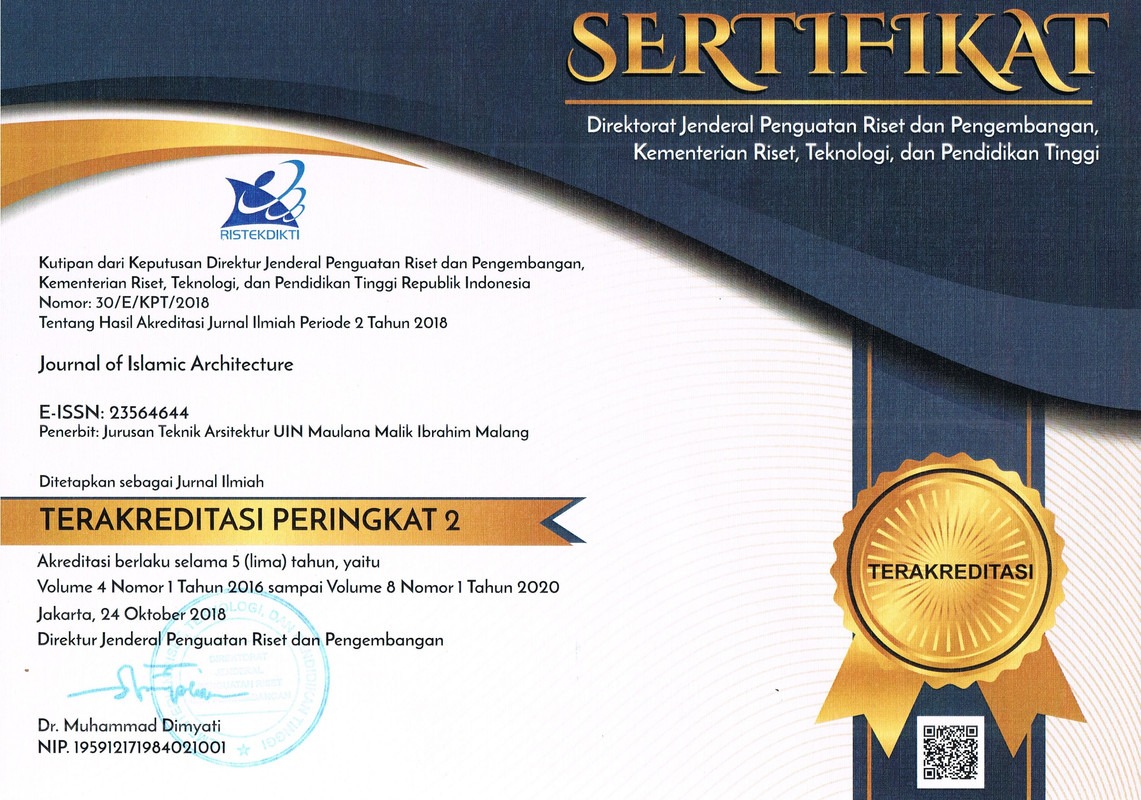THE INFLUENCE OF NATURAL IDEAS IN PROMOTING GENIUS LOCI (CASE STUDY OF SHEIKH LOTFOLLAH MOSQUE IN ISFAHAN)
Abstract
Keywords
Full Text:
PDFReferences
A. Dahar and R. Alipour, “Geometric Analysis of Sheikh Lotfollah Mosque in Isfahan: Determining the Relationship of the Prayer Room with the Forecourt of the Building,” Q. Bagh Nazar, vol. 10, no. 26, pp. 33–40, 2013.
M. Hejazi, “Geometry in nature and Persian architecture,” Build. Environ., vol. 40, no. 10, pp. 1413–1427, 2005.
C. Norberg-Schulz, “Genius Loci: Towards a Phenomenology of Architecture,” Genius loci: Towards a phenomenology of architecture. p. 212, 1991.
P. Partuiee, Phenomenology of the place. Tehran: Islamic Republic of Iran Art Academy, 2008.
J. K. Grütter, “Ästhetik der Architektur Grundlagen der Architektur-Wahrnehmung,” 1987.
D. Seamon, “The phenomenological contribution to environmental psychology,” Journal of Environmental Psychology, vol. 2, no. 2. pp. 119–140, 1982.
N. Ardalan and L. Bakhtiar, Sense of Unity. Tehran: Science Architect, 2011.
A. Madanipour, Design of urban space: an inquiry into a socio-spatial process. John Wiley & Son Ltd, 1996.
K. Afshar-Naderi, “From User to Location,” J. Archit., no. 6, 2000.
L. Medqalchi, M. Ansari, and M. Bemanian, “The Spirit of the Place in the Iranian Garden,” Q. Bagh-Nazar, vol. 11, no. 28, pp. 25–38, 2014.
H. Nasr, Knowledge and Spirituality. Tehran: Sohrevardi Research and Publishing Office, 2001.
B. Vasiq, A. Pashootnizadeh, and B. Mohammadreza, “Place and Housing in the Viewpoint of Islam,” Interdiscip. Stud. Holy Qur’an, no. 3, pp. 93–101, 2009.
A. Noqrehkar, M. Hamze-Nejad, and M. Dehghani-Tafti, “Investigating the Impact of the Natural Environment on Behavior and Ethics from the Point of View of Islamic thinkers and its Results in Designing the Artificial Environments,” Arman Shahr J., vol. 3, no. 5, pp. 79–96, 2010.
R. M. Sani, “A CONCEPTUAL UNDERSTANDING FOR TEACHING THE HISTORY OF ISLAMIC ARCHITECTURE : AN IRANIAN ( PERSIAN ) PERSPECTIVE Rafooneh Mokhtarshahi Sani,” Archnet-IJAR, Int. J. Archit. Res., vol. 3, no. 1, pp. 233–244, 2009.
V. Taqvaiee, “The hidden space system of Iranian architecture and its structure,” Fine Arts J., no. 30, pp. 43–52, 2007.
S. Jahanshahi, “The collection of mosque patterns with light hierarchy approach to perception space of architecture (Case Study: Ganjalikhan Mosque and Sheykh Lotfollah Mosque,” J. Sci. Res. Dev., vol. 2, no. 2, pp. 174–180, 2015.
M. Bemanian and S. Silvaieh, “Investigating the role of the dome in shaping the center of the mosque architecture,” Arman Shahr Archit. Urban Des. J., vol. 5, no. 9, pp. 19–30, 2012.
DOI: https://doi.org/10.18860/jia.v5i2.4807
Refbacks
- There are currently no refbacks.







